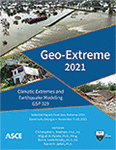Bioremediation of Tsunami Affected Contaminated Soil in Tohoku, Japan
Publication: Geo-Extreme 2021
ABSTRACT
The Tohoku earthquake which was 9.0 magnitude mega earthquake caused a huge tsunami on March 11, 2011, in the northern part of Japan. This tsunami caused a great damage to the land area with high-salt content. A high content of salt in soil makes it unsuitable for crop production. Traditional method such as leaching with fresh water was expensive for a wide area and the discharge of saline water was another big challenge in the damaged infrastructure. In this study, a series of laboratory test was conducted to investigate the ability of bioremediation to reduce the salinity of soil samples. Saline soil was prepared after soaking the test soil in artificial seawater for three days and dried it to make it as a tsunami affected saline soil. It was then mixed with different microorganisms. Soil samples were collected to measure the electrical conductivity (EC), which is directly related to chloride content, regularly at different specified depths using a portable electrical conductivity meter. It was found that the electrical conductivity reduced with the help of the bacterial activities and the collective microorganism (CM 2) was more effective than the other microbes.
Get full access to this article
View all available purchase options and get full access to this chapter.
REFERENCES
Andreolli, M., Lampis, S., Poli, M., Gullner, G., Biró, B., and Vallini, G. (2013). Endophytic Burkholderia fungorumDBT1 can improve phytoremediation efficiency of polycyclic aromatic hydrocarbons. Chemosphere. ;92:688–694.
Bacilio, M., Rodriguez, H., Moreno, M., Hernandez, J.-P., Bashan, Y. (2004). Mitigation of salt stress in wheat seedlings by agfp-tagged Azospirillum lipoferum. Biol. Fertility Soils 40, 188–193.
Cai, B., Ma, J., Yan, G., Dai, X., Li, M., and Guo, S. (2016). Comparison of phytoremediation, bioaugmentation and natural attenuation for remediating saline soil contaminated by heavy crude oil. Biochem Eng J.;112:170–177.
Gao, Y., Wang, J., Xu, J., Kong, X., Zhao, L., and Zeng, D.-H. (2013). Assessing the quality of oil-contaminated saline soil using two composite indices. Ecol Indic. 24:105–112.
Glick, B. R., Cheng, Z., Czarny, J., and Duan, J. (2007). Promotion of plant growth by ACC deaminase-producing soil bacteria. Eur. J. Plant Pathol. 119, 329–339.
Inui, T., Yasutaka, T., Endo, K. and Katsumi, T. (2012). Geo-environmental issues induced by the 2011 off the Pacific Coast of Tohoku Earthquake and tsunami. Soils and Foundation, 52 (5): 856–871.
Katsumi, T., Takai, A., Omine, K., Kazama, M., and Inui, T. (2011). Physical and chemical properties of tsunami deposits collected in the flooded area, Miyagi Prefecture. In: Proceedings of the Annual Symposium on Groundwater and Geo-environment. The Research Committee of Groundwater and Geo-environment pp. 83–90 (in Japanese).
Moqsud, M. A., and Soga, K. (2019). Bioremediation of high saline soil through the home-made collective microorganisms. Geo-congress, Philadelphia, USA.
Moqsud, M. A., Kodama, Y., Omine, K., and Yasufuku, N. (2017). Bioremediation of Unsaturated saline soil. Proceedings of the second Pan-American conference on unsaturated soils., November 12-15, Dallas, Texas, USA.
Moqsud, M. A., and Omine, K. (2013). Bioremediation of agricultural land damaged by tsunami. Biodegradation of Hazardous and special products. INTCH Publishers.
Oguchi, M. O., Takigami, H., Higashi, H., Endo, K., and Mizutani, C. (2012). Effective use of Information regarding land use and location of facilities for investigating chemical pollution in tsunami deposit. Material Cycles and Waste Management Research, 23 (1), pp. 60–71(in Japanese).
Olivera, N., Sineriz, F., and Breccia, J. D. (2005). Bacillus patagoniensis sp. nov., a novel alkali tolerant bacterium from the rhizosphere of Atriplex lampa in Patagonia, Argentina. International Journal of Systematic and Evolutionary Microbiology, 55, 443–447.
Omine, K., Moqsud, M. A., and Raja, E. (2012). Soil restoration of agricultural land damaged by sea water in Tohoku earthquake 2011. International Journal of Environment. 2(2). 128–134.
Serrano, R. (1996). Salt tolerance in plants and microorganisms: toxicity targets and defense responses, International Review of Cytology, vol. 165, pp. 1–52.
Shannon, M. C., and Grieve, C. M. (1999). Tolerance of vegetable crops to salinity. Sci. Horticulture 78, 5–38.
Sugita, F. (2012). Impact of Tsunami caused by the 2011 off the Pacific coast of Tohoku Earthquake on groundwater usage and quality in Asahi-city, Chiba Prefecture Japan Journal of Groundwater Hydrology, 54 (1) (2012), pp. 25–37 (in Japanese).
Takai, A., Endo, K., Yasutaka, T., and Katsumi, T. (2012). Distribution and characterization of tsunami sediments in Fukushima Prefecture. In: Proceedings of the 47th JGS Conference on Soil Mechanics and Geotechnical Engineering, pp. 1951–1952 (in Japanese).
Yumoto, I., Yamaga, S., Sogabe, Y., Nodasaka, Y., Matsuyama, H., and Nakajima, K. (2003). Bacillus krulwichiae sp. nov., a halotolerant obligate alkaliphile that utilizes benzoate and mhydroxybenzoate. International Journal of Systematic and Evolutionary Microbiology, 53, 1531–1536.
Information & Authors
Information
Published In
Copyright
© 2021 American Society of Civil Engineers.
History
Published online: Nov 4, 2021
Authors
Metrics & Citations
Metrics
Citations
Download citation
If you have the appropriate software installed, you can download article citation data to the citation manager of your choice. Simply select your manager software from the list below and click Download.
